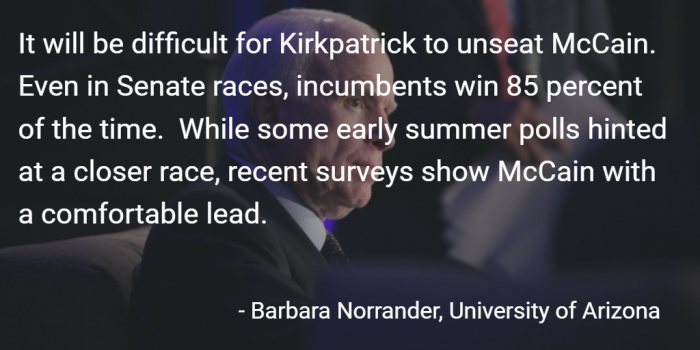 John McCain has been one of the Grand Canyon state’s US Senators for nearly three decades. But will he be dragged out of office by Donald Trump’s falling national popularity? As part of our series covering key Senate races in the 2016 election Barbara Norrander writes that in the Arizona race, McCain’s challenger, Ann Kirkpatrick – though behind in the polls – could benefit if Republicans are unwilling to vote for Donald Trump stay at home in November or if there is a surge in Latino voters.
John McCain has been one of the Grand Canyon state’s US Senators for nearly three decades. But will he be dragged out of office by Donald Trump’s falling national popularity? As part of our series covering key Senate races in the 2016 election Barbara Norrander writes that in the Arizona race, McCain’s challenger, Ann Kirkpatrick – though behind in the polls – could benefit if Republicans are unwilling to vote for Donald Trump stay at home in November or if there is a surge in Latino voters.
“Build the wall” might be expected to be a big issue for the 2016 Arizona senate race, given the state’s location along the Mexican border. After all, Donald Trump won the Republican presidential nomination with a proposal for a border wall that Mexico would pay for. In Republican Senator John McCain’s bid for reelection in 2010, he also proclaimed the need to “complete the danged fence.” (About one-third of the border currently has fencing.) Yet in the 2016 Arizona senate race, the notion of a border wall takes second place to a more nuanced discussion about immigration reform. In the only debate between Republican incumbent John McCain and Democratic challenger Ann Kirkpatrick, both focused on the need for a comprehensive immigration reform law, though they blamed each other for the lack of such a reform. Their approaches to border security focus on alternatives to a physical wall, such as the increased use of drones (McCain) or the need for more consultation with those living on the border (Kirkpatrick).
Candidates’ advertising strategies
The air wars between the two taint the opponent with ties to national issues. McCain attacks Kirkpatrick for her support of Obamacare and Hillary Clinton. Obamacare has not been a popular issue in Republican-leaning Arizona, and recent news stories focus on only one insurance company providing coverage in 14 of the 15 Arizona counties in 2017. McCain’s ads also depict Kirkpatrick as too liberal for Arizona and criticize her support for the Iranian nuclear deal. In contrast, McCain touts his history as a war veteran and chair of the Senate Armed Services Committee.
Kirkpatrick’s ads depict McCain as a Washington insider who has lost touch with the state. McCain is seeking his sixth term in the senate, leading Kirkpatrick to advocate for term limits. Kirkpatrick also ties McCain to Trump in her ads, first criticizing him for supporting Trump and now asking why it took so long for McCain to withdraw his support for the GOP’s presidential candidate. Meanwhile, Kirkpatrick emphasizes her family’s long ties to Arizona, and her campaign logo includes a pair of cowboy boots.
Courting the Latino vote
Both candidates are courting a potentially larger Latino vote through Spanish-language ads. McCain ads recall his role in the Senate in producing a comprehensive immigration reform bill, though that bill failed to make it through the House. Kirkpatrick counters by tying McCain to Trump, and his opposition to Mexican immigrants, in her Spanish-language ads. The size of the Latino vote in 2016 remains in question. Fourteen Latino rights groups came together under the banner of One Arizona. The group met its original goal for 2016 of registering 75,000 new voters and expanded its goal to 125,000. One Arizona reports that in 2012, Latinos comprised 17 percent of Arizona’s voters while the Pew Research Center calculates that Latinos are 22 percent of the potential Arizona electorate. Increasing the number of Latino voters to match their potential is a challenging task, just as it is to register any new group of voters in the US.

The power of incumbency
Recently political scientists have focused on the nationalization of congressional elections, while asserting that the old phrase “all politics is local” is passé. McCain hopes that the latter phrase holds true in 2016. As a long-term incumbent senator he points to a number of ways he has helped Arizonans, from protecting military bases near Phoenix and Tucson to supporting redevelopment projects in smaller towns. McCain also holds a numerical advantage over Kirkpatrick, as Arizona’s 3.4 million registered voters break down as 35 percent Republican, 30 percent Democrat and 34 percent independent.
It will be difficult for Kirkpatrick to unseat McCain. Even in Senate races, incumbents win 85 percent of the time. While some early summer polls hinted at a closer race, recent surveys show McCain with a comfortable lead. Kirkpatrick is not well known in the state. She represented a rural congressional district, while nearly two-thirds of the state’s residents live in the Phoenix metropolitan area. Still, Kirkpatrick has been relatively successful at raising campaign funds at $5.8 million, though McCain as the incumbent has the advantage at $12.2 million. At least, Kirkpatrick’s resources will allow her to continue a vigorous campaign up to Election Day. But she is on her own. Outside groups and the national parties have not targeted the Arizona senate race as competitive enough to warrant their attention.
How Kirkpatrick could win
Kirkpatrick’s best hopes for victory lie with spillover from the presidential race. Two scenarios would have McCain losing support from Republican voters. The first scenario would occur if enough Republican voters stay home on Election Day being unwilling to vote for either Trump or Clinton. A second scenario for McCain losing votes focuses on another type of Republican voter, that of the Trump supporter who is upset with McCain’s recent withdrawal of his endorsement of Trump. These disgruntled Trump supporters may forgo the senate portion of the Arizona ballot. Other scenarios would count on a larger Democratic vote. If Clinton has an upset victory in Arizona, voters may continue to vote for Democrats in down-ballot races. Finally, a surge in Latino voters would benefit both Clinton and Kirkpatrick. All of these scenarios, however, are less likely than another reelection victory for John McCain.
Featured image credit: Gage Skidmore (Flickr, CC-BY-SA-2.0)
Please read our comments policy before commenting.
Note: This article gives the views of the author, and not the position of USAPP – American Politics and Policy, nor of the London School of Economics.
Shortened URL for this post: http://bit.ly/2egWU7k
_______________________________
 Barbara Norrander – University of Arizona
Barbara Norrander – University of Arizona
Barbara Norrander is a professor in the School of Government and Public Policy at the University of Arizona, where she specializes in electoral politics. Her most recent book is The Imperfect Primary: Oddities, Biases, and Strengths of US Presidential Nomination Politics, 2nd edition (Routledge, 2015).






